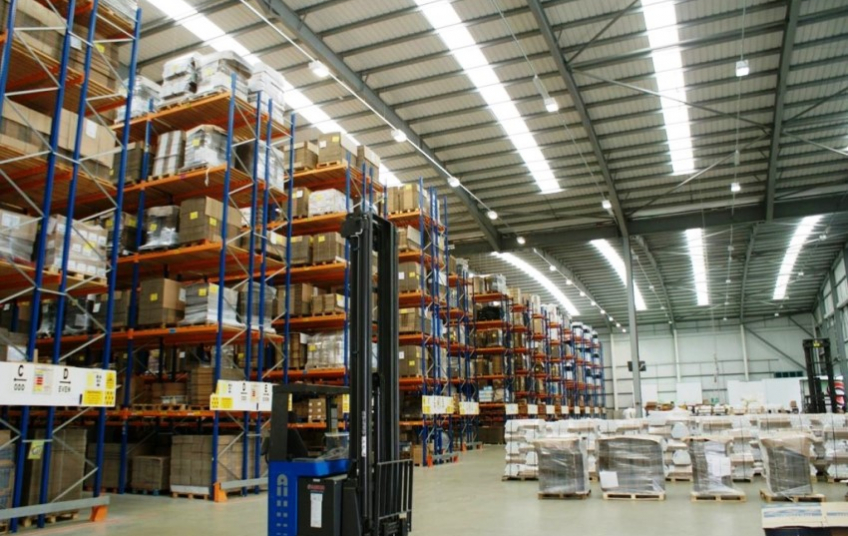You ordered something online, and you get a knock on your door in a few days. You open the door and find your package, but how did it get there? Besides the obvious answer that the delivery man from a big company like FedEx or UPS brought it, what happened between the time you ordered your package to the time it was brought to your front door? A lot more goes into you receiving your package than you think. Many different factors are considered to ensure that a package arrives to the right person unharmed.
There are four principal functions of packaging, one being transportation. Distributing or transporting packages is fundamental to packaging since everything must be shipped either directly to the consumer or to a company or store. Transporting a package is more than just putting it in the back of a truck, train, or airplane and sending it to the consumer. Companies must choose the correct packaging and package it properly to ensure that the products reach the consumer or company in one piece. Not only that, but other factors need to be considered such as vibrations, shock, weather, and sometimes temperature, which also helps companies decide on the packaging design. Every product has different packaging needs, which is why there are so many different tests that go into packaging and transporting a package.
There are different types of packaging and levels of packaging. There is consumer packaging, which, according to Investopedia, “are items used daily by average consumers that require routine replacement or replenishment, such as food, beverages, clothes, tobacco, makeup, and household products.” These kinds of packaging are intended for everyday use products. They usually have a lot of colors and graphics on them that attract the consumers’ eyes. Other types of packaging include industrial packaging, military packing, and institutional packaging. Industrial packaging is usually done on a larger scale. Institutional packaging is usually intended for items bought in bulk for different institutions. Hotels and restaurants usually utilize this type of packaging because, unlike consumer packaging, institutional packaging is extremely simple and does not have many graphics that go into it. The packaging is not used to attract consumers. Military packaging is used for weaponry and other military products. It is extremely vital that the military packaging is done right to ensure everyone’s safety. Not only are there different kinds of packaging, but there are different levels of packaging such as primary, secondary, and tertiary packaging. Packaging is much more complex than putting an item in a box and sending it out. The type and level of packaging all go into how the shipment is packaged and transported.
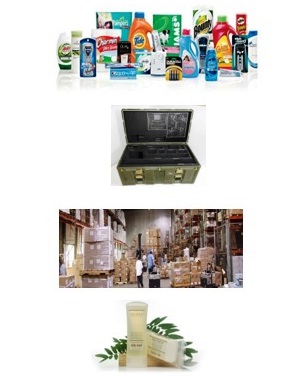
Above are the different types of packaging. There is consumer packaging, military packaging, industrial packaging, and institutional packaging.
No matter the type or level of packaging, each type is susceptible to hazards if not distributed correctly. A package can undergo damage due to distribution hazards such as shock hazards, vibration hazards, compression hazards, and environmental hazards. If the correct steps are not taken, each of these hazards can jeopardize the packaging and cause damage to the product. Therefore, different tests are conducted to create the best packaging for each product. That way if any package undergoes any of the distribution hazards, it will have minimal damage due to the consideration that was put into its design.
One type of distribution hazard is shock hazard. Shock hazards arise from dropping a package, which can be done intentionally or unintentionally. A delivery man can throw a package at someone’s front steps, or a package can fall off a shelf at a warehouse. Not only that, but shock can occur when a package is dropped during the handling of it during sorting, vehicle loading and unloading, delivery, manual palletizing, stacking and unstacking, moving and positioning, and placing it in or out of racks. No matter how the package is dropped, it undergoes a shock in a short duration of time with high intensity. This high intensity dynamic event is characterized by a sudden change in velocity. This type of hazard can be simulated in a lab using a drop test and an impact test to evaluate the package under shock to develop ways to improve the packaging. The intensity of the shock is generally measured in terms of its peak acceleration in g or G and is also characterized by the total velocity change. These tests are used to design packages that can protect the products from impacts.
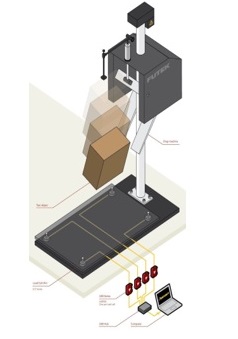
Another type of distribution hazard is vibration. Vibration hazards can occur during transportation, and it can be from the truck vibrations, which can result from the up and down movement of the truck. Not only that, but different road conditions can result in different vibrations. Vibrations can also be a result of turbulence in airplanes or earthquakes and are common in transportation vehicles, lift trucks, conveyors, and other machinery. Vibration in transportation is also influenced by many factors such as vehicle suspension, vehicle structure, and the conditions of the road, water, rail, or air and it can occur in all directions. Unlike shock hazards, vibration happens over a long duration and is low impact. It usually oscillates around a reference point. One cause of damage in transportation related to vibration is a result of something known as resonance. Resonance occurs when the frequency of a vibration matches its natural frequency and the system over responds and amplifies the motion of the support. A vibration table is used to simulate vibrations to analyze its effects on the package.
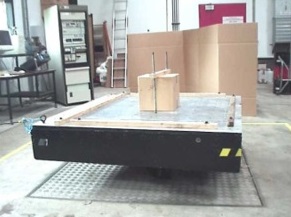
Compression hazard is the distribution hazard due to compression of packages. This is usually a result of stacking packages, especially in warehouses. Individual and unitized products are stacked in warehouses to utilize their height. The time a package stays in a warehouse can be short or long, which means that the time the package undergoes compression can differ. The package compression strength reduces over time. So, the longer a package is compressed, the weaker it becomes. A compression test, such as the one pictured below, is used to simulate a package undergoing compression for different weights and time durations. Just like the shock and vibration tests, this is used to analyze the package to improve it.
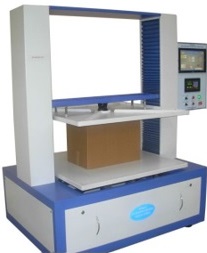
Another distribution hazard that can greatly affect a package is environmental hazards. Environmental hazards can include humidity, temperature, light, pressure, and altitude. Humidity can weaken a package, which could cause collapsing of the package. High humidity decreases the compression strength of a package and low humidity can dry moist products. High temperatures can affect packages that contain food or medical supplies. It could decrease shelf life, accelerate deterioration, or result in chemical reactions or biological changes to products such as food. To test the different environmental conditions, many test protocols are used, especially for pressure, temperature, and humidity. A machine, such as the one pictured below, can be used to test these different environmental conditions that could affect a package.
There are numerous hazards that can greatly damage a package. Fortunately, there are ways to prevent these hazards from occurring. According to Shipping Easy, one way to prevent damage caused by dropping or compression is to “use a heavy-duty cardboard box” such as two plies. Looking into the box’s weight, crush limits, and box certificate can help ensure that the best quality boxes are being used. For fragile items, Shipping Easy recommends using “a double box method with 2” - 3” of cushioning between the two boxes, as well as surrounding the inner contents.” Other ways to improve the packaging to prevent damage from dropping or compression is to use sturdy packing material and strong adhesive tape. Using materials such as packing peanuts and bubble wrap can protect items in a package if it is dropped. Taping a box closed in an H pattern can also help prevent boxes from opening as stated by Shipping Easy.
There is no doubt that a package will undergo vibration hazards when being transported, but there are ways to lessen the damage that this hazard can cause. The first step to prevent damage caused by vibration is to consider the frequency at which the packages will vibrate. This way, a manufacturer will be able to figure out what they need to use to prevent damage. One way to prevent damage that can result from vibration is to “Choose cushioning with enough density or staying power to keep items from shifting” (Shipping Easy). Adding extra protection, wrapping, and taping edges can also help prevent damage to the package.

Just like shock, compression, and vibration, there are ways to prevent environmental hazards from damaging packages. According to Shipping Easy, “When shipping to humid climates or if your contents are particularly sensitive to changes in humidity, include non-toxic drying agent desiccants such as small silicon gel packs inside the cartons.” Another way is to wrap items in plastic before packing them. For example, paper-based items can be damaged if they get wet. So, wrapping these items in plastic prevents them from getting ruined by the rain.
Taking these simple steps to prevent damage caused by distribution hazards benefits everyone in the long run. Manufacturers and companies can save on time and money by taking the steps necessary to prevent damage. One reason is because manufacturers will not have to worry about replacing damaged goods or reshipping items. Not only that, but by preventing any damage that may occur during distribution ensures the quality of the products. For example, items such as food or medical products can undergo chemical reactions or biological changes due to environmental hazards, which could greatly harm a person if consumed. By taking simple measures, manufacturers can be certain that the products that are reaching consumers will not cause them any harm to their health. Putting a little extra time and money to avoid distribution hazards will be extremely beneficial and be in everyone’s best interest.
So, a lot of things happened between the time you ordered your package and received it at your door. Before your package could even be shipped, tests such as compression tests, vibration tests, drop tests, and environmental tests had to be performed to make certain that no harm would come to it. After those tests were conducted, the results were then analyzed to create the best packaging conditions and the right package was chosen for your product. Then your package was transported to the correct facilities until it reached your front doorstep. All of this was done to guarantee that you received your package on time and in the best condition.
References:
https://www.investopedia.com/terms/c/cpg.asp
https://www.brandchannel.com/2012/02/17/why-consumer-goods-brands-must-think-mor e-like-retailers/
https://www.acmepaper.com/acme-divisions/industrial-packaging.aspx 4. https://www.basiccrating.com/military-packing/
https://www.manmonthly.com.au/package-drop-testing-solution
https://www.protopakengineering.com/sites/default/files/vibration.jpg
http://mcsparr.com/images/products/large/box_compression_strength_tester_touch_scree n_model.jpg
https://img.trueniu.net/wp-content/uploads/sites/43/2019/01/16175502/environmental-cha mber.jpg
https://support.shippingeasy.com/hc/en-us/articles/203083029-Packing-Tips-Protecting-Packages-from-Shipping-Hazards





























